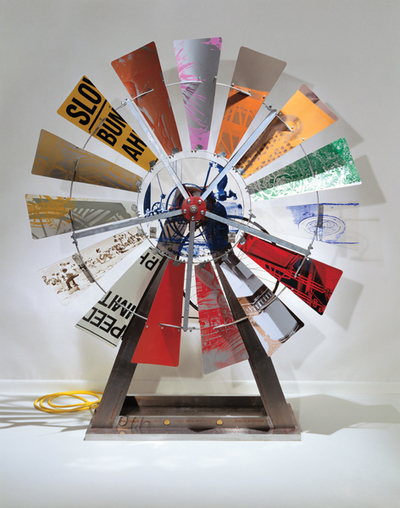PUSHING BOUNDARIES: DINE, GRAVES, LICHTENSTEIN, RAUSCHENBERG AND ROSENQUIST— COLLABORATIONS WITH DONALD SAFF

Robert Rauschenberg, Eco-Echo VIII, 1993, aluminum, sonar-activated motor, bicycle wheel, galvanized-steel windmill hardware, street signs, screenprinted acrylic, and hand-painting on aluminum and Lexan, 88½ x 73½ x 26½”. Collaboration: Donald Saff, Nick Conroy, Ken Elliot, Patrick Foy, George Holzer, and Conrad Schwable; assisted by Tim Amory, Maggi De Lamater, and Madeleine Shinn. From the collection of Saff Tech Arts.
Engineer, art historian, educator, and master printmaker by training, Brooklyn-born Donald Saff arrived in New York City in the late 1950s just in time to catch abstract expressionism.Excited by what he saw, Saff wanted to get in on the action. He launched Graphicstudio—a printmaking studio extraordinaire—at the University of South Florida in 1968 as a means to “midwife projects that had a bigger scale and a more imposing physical presence than conventional prints,” as Avis Berman recounts in her introduction to Donald Saff: Art in Collaboration (2010).
This exhibition offers ample evidence of Saff’s genius as instigator and enabler. Working with a number of giants of late 20th-century American art, he helped them think outside the printmaking box. In many cases they embraced three-dimensional concepts. With Roy Lichtenstein, he made “brushstroke” chair and ottoman ensembles, with James Rosenquist, tiny 18-karat gold trash cans. Robert Rauschenberg’s Eco-Echo VIII, 1993, is based on a windmill concept Saff pitched to the artist. With its sonaractivated motor, the sculpture turns when viewers near it. A few blades are repurposed street signs: “slow bump ahead” becomes a bit of found poetry: “slo bum ah.”
Surely the inventive sculptor Nancy Graves (1939–95) needed no help coming up with ideas, yet Saff managed to assist her in her explorations. For the brilliantly surreal Unending Revolution of Venus, Plants, and Pendulum, 1991–92, the crew at Saff Tech Arts, the workshop he started in Maryland in 1991, fabricated castings of various objects and shared them with Graves. Saff recalls that while the artist was open to “discussions about the work,” she was “single-minded” when it came to final assemblage.
Saff became senior curator of prints and drawings for the Guggenheim Foundation in 2003 and then its senior curator of special projects the following year. More recently, he has explored his passion for 19th-century clocks (his “Clock B” was awarded a certificate from Guinness World Records in 2015 for being the most accurate pendulum clock). Whatever the boundaries, Saff has never shied away from pushing them.
